Wednesday, March 18, 2009
The New Face of Facebook
Friday, November 21, 2008
Its not IT ... but we owe it to Berners Lee
CERN inaugurates the LHC
Geneva, 21 October 2008. Swiss President Pascal Couchepin and French Prime Minister François Fillon were joined at CERN1 today by science ministers from CERN’s Member States and around the world to inaugurate the Large Hadron Collider, the world’s largest and most complex scientific instrument.
“Today is a day for CERN to thank its Member States for their continued support for basic science, and for providing the stable framework that makes science of this kind possible,” said CERN Director General Robert Aymar. “It is also a day for CERN and the global particle physics community to take a sense of pride in the achievement of bringing this unique facility from dream to reality, a process that has taken over two decades of careful planning, prototyping and construction, culminating with the successful circulation of the machine’s first protons in front of a global audience on 10 September this year.”
The inauguration ceremony consisted of speeches, exhibitions and a new audiovisual concert, “ORIGINS”, an adaptation of “LIFE: A Journey Through Time”, featuring the imagery of National Geographic photographer Frans Lanting and the music of Philip Glass, performed by the Orchestre de la Suisse Romande conducted by Carolyn Kuan.
“The younger generations target their ambitions on what they experience while growing up,” said President of CERN Council, Torsten Åkesson. “Science and technology need flagships that stand out and catch the eye, excite fantasy and fuel curiosity. The LHC is one such flagship.”
The ceremony was followed by a buffet of molecular gastronomy presented by Chef Ettore Bocchia, and was made possible thanks to the generous support of a range of sponsoring companies and organizations2, most of which have contributed to the construction of the LHC.
“The LHC is the largest and most sophisticated scientific instrument ever built. There have been many challenges along the way, which have all been overcome one after the other,” said LHC Project Leader Lyndon Evans. “We are now looking forward to the start of the experimental programme. The adventure of building the LHC will end and a new adventure of discovery will begin.”
What is the GNU GPL? Shiv answers....
The Foundations of the GPL
Nobody should be restricted by the software they use. There are four freedoms that every user should have:
- the freedom to use the software for any purpose,
- the freedom to change the software to suit your needs,
- the freedom to share the software with your friends and neighbors, and
- the freedom to share the changes you make.
When a program offers users all of these freedoms, we call it free software.
Developers who write software can release it under the terms of the GNU GPL. When they do, it will be free software and stay free software, no matter who changes or distributes the program. We call this copyleft: the software is copyrighted, but instead of using those rights to restrict users like proprietary software does, we use them to ensure that every user has freedom.
We update the GPL to protect its copyleft from being undermined by legal or technological developments. The most recent version protects users from three recent threats:
- Tivoization: Some companies have created various different kinds of devices that run GPLed software, and then rigged the hardware so that they can change the software that's running, but you cannot. If a device can run arbitrary software, it's a general-purpose computer, and its owner should control what it does. When a device thwarts you from doing that, we call that tivoization.
- Laws prohibiting free software: Legislation like the Digital Millennium Copyright Act and the European Union Copyright Directive make it a crime to write or share software that can break DRM (Digital Restrictions Mismanagement; see below). These laws should not interfere with the rights the GPL grants you.
- Discriminatory patent deals: Microsoft has recently started telling people that they will not sue free software users for patent infringement—as long as you get the software from a vendor that's paying Microsoft for the privilege. Ultimately, Microsoft is trying to collect royalties for the use of free software, which interferes with users' freedom. No company should be able to do this.
Version 3 also has a number of improvements to make the license easier for everyone to use and understand. But even with all these changes, GPLv3 isn't a radical new license; instead it's an evolution of the previous version. Though a lot of text has changed, much of it simply clarifies what GPLv2 said. With that in mind, let's review the major changes in GPLv3, and talk about how they improve the license for users and developers.
Neutralizing Laws That Prohibit Free Software — But Not Forbidding DRM
You're probably familiar with the Digital Restrictions Mismanagement (DRM) on DVDs and other media. You're probably also familiar with the laws that make it illegal to write your own tools to bypass those restrictions, like the Digital Millennium Copyright Act and the European Union Copyright Directive. Nobody should be able to stop you from writing any code that you want, and GPLv3 protects this right for you.
It's always possible to use GPLed code to write software that implements DRM. However, if someone does that with code protected by GPLv3, section 3 says that the system will not count as an effective technological "protection" measure. This means that if you break the DRM, you'll be free to distribute your own software that does that, and you won't be threatened by the DMCA or similar laws.
As usual, the GNU GPL does not restrict what people do in software; it just stops them from restricting others.
Protecting Your Right to Tinker
Tivoization is a dangerous attempt to curtail users' freedom: the right to modify your software will become meaningless if none of your computers let you do it. GPLv3 stops tivoization by requiring the distributor to provide you with whatever information or data is necessary to install modified software on the device. This may be as simple as a set of instructions, or it may include special data such as cryptographic keys or information about how to bypass an integrity check in the hardware. It will depend on how the hardware was designed—but no matter what information you need, you must be able to get it.
This requirement is limited in scope. Distributors are still allowed to use cryptographic keys for any purpose, and they'll only be required to disclose a key if you need it to modify GPLed software on the device they gave you. The GNU Project itself uses GnuPG to prove the integrity of all the software on its FTP site, and measures like that are beneficial to users. GPLv3 does not stop people from using cryptography; we wouldn't want it to. It only stops people from taking away the rights that the license provides you—whether through patent law, technology, or any other means.
Stronger Protection Against Patent Threats
In the 17 years since GPLv2 was published, the software patent landscape has changed considerably, and free software licenses have developed new strategies to address them. GPLv3 reflects these changes too. Whenever someone conveys software covered by GPLv3 that they've written or modified, they must provide every recipient with any patent licenses necessary to exercise the rights that the GPL gives them. In addition to that, if any licensee tries to use a patent suit to stop another user from exercising those rights, their license will be terminated.
What this means for users and developers is that they'll be able to work with GPLv3-covered software without worrying that a desperate contributor will try to sue them for patent infringement later. With these changes, GPLv3 affords its users more defenses against patent aggression than any other free software license.
Clarifying License Compatibility
If you found some code and wanted to incorporate it into a GPLed project, GPLv2 said that the license on the other code was not allowed to have any restrictions that were not already in GPLv2. As long as that was the case, we said the license was GPL-compatible.
However, some licenses had requirements that weren't really restrictive, because they were so easy to comply with. For example, some licenses say that they don't give you permission to use certain trademarks. That's not really an additional restriction: if that clause wasn't there, you still wouldn't have permission to use the trademark. We always said those licenses were compatible with GPLv2, too.
Now, GPLv3 explicitly gives everyone permission to use code that has requirements like this. These new terms should help clear up misunderstandings about which licenses are GPL-compatible, why that is, and what you can do with GPL-compatible code.
New Compatible Licenses
In addition to clarifying the rules about licenses that are already GPL-compatible, GPLv3 is also newly compatible with a few other licenses. The Apache License 2.0 is a prime example. Lots of great free software is available under this license, with strong communities surrounding it. We hope that this change in GPLv3 will foster more cooperation and sharing within the free software community.
More Ways for Developers to Provide Source
One of the fundamental requirements of the GPL is that when you distribute object code to users, you must also provide them with a way to get the source. GPLv2 gave you a few ways to do this, and GPLv3 keeps those intact with some clarification. It also offers you new ways to provide source when you convey object code over a network. For instance, when you host object code on a web or FTP server, you can simply provide instructions that tell visitors how to get the source from a third-party server. Thanks to this new option, fulfilling this requirement should be easier for many small distributors who only make a few changes to large bodies of source.
The new license also makes it much easier to convey object code via BitTorrent. First, people who are merely downloading or seeding the torrent are exempt from the license's requirements for conveying the software. Then, whoever starts the torrent can provide source by simply telling other torrent users where it is available on a public network server.
These new options help keep the GPL in line with community standards for offering source, without making it harder for users to get.
Less Source to Distribute: New System Libraries Exception
Both versions of the GPL require you to provide all the source necessary to build the software, including supporting libraries, compilation scripts, and so on. They also draw the line at System Libraries: you're not required to provide the source for certain core components of the operating system, such as the C library.
GPLv3 has adjusted the definition of System Library to include software that may not come directly with the operating system, but that all users of the software can reasonably be expected to have. For example, it now also includes the standard libraries of common programming languages such as Python and Ruby.
The new definition also makes it clear that you can combine GPLed software with GPL-incompatible System Libraries, such as OpenSolaris' C library, and distribute them both together. These changes will make life easier for free software distributors who want to provide these combinations to their users.
A Global License
GPLv2 talks about "distribution" a lot—when you share the program with someone else, you're distributing it. The license never says what distribution is, because the term was borrowed from United States copyright law. We expected that judges would look there for the definition. However, we later found out that copyright laws in other countries use the same word, but give it different meanings. Because of this, a judge in such a country might analyze GPLv2 differently than a judge in the United States.
GPLv3 uses a new term, "convey," and provides a definition for that term. "Convey" has the same meaning we intended for "distribute," but now that this is explained directly in the license, it should be easy for people everywhere to understand what we meant. There are other minor changes throughout the license that will also help ensure it is applied consistently worldwide.
When the Rules Are Broken: A Smooth Path to Compliance
Under GPLv2, if you violated the license in any way, your rights were automatically and permanently lost. The only way to get them back was to petition the copyright holder. While a strong defense against violations is valuable, this policy could cause a lot of headache when someone accidentally ran afoul of the rules. Asking all the copyright holders for a formal restoration of the license could be burdensome and costly: a typical GNU/Linux distribution draws upon the work of thousands.
GPLv3 offers a reprieve for good behavior: if you violate the license, you'll get your rights back once you stop the violation, unless a copyright holder contacts you within 60 days. After you receive such a notice, you can have your rights fully restored if you're a first-time violator and correct the violation within 30 days. Otherwise, you can work out the issue on a case-by-case basis with the copyright holders who contacted you, and your rights will be restored afterward.
Compliance with the GPL has always been the top priority of the FSF Compliance Lab and other groups enforcing the license worldwide. These changes ensure that compliance remains the top priority for enforcers, and gives violators incentive to comply.
The Latest and Greatest
Some of these changes probably seem less important to you than others. That's okay. Every project is different, and needs different things from its license. But odds are that a number of these improvements will help you and your work.
And taken as a whole, all these upgrades represent something more: we made a better copyleft. It does more to protect users' freedom, but it also enables more cooperation in the free software community. But updating the license is only part of the job: in order for people to get the benefits it offers, developers need to use GPLv3 for their projects, too. By releasing your own software under the new license, everyone who deals with it—users, other developers, distributors, even lawyers—will benefit. We hope you'll use GPLv3 for your next release.
If you'd like to learn more about upgrading your project to GPLv3, the FSF Compliance Lab would be happy to assist you. On our web site, you can find basic instructions for using the license, and an FAQ addressing common concerns that people have about it. If your situation is more complicated than that, please contact us and we'll do what we can to help you with your transition. Together, we can help protect freedom for all users.
Wednesday, November 19, 2008
Why a new OS doesnt stand a chance!!
If you look at the state of the operating system world today, it is fairly easy to name the operating systems that have gained mainstream acceptance (which doesn't mean that it has to have a huge market share). We all know the likes of Windows, OS X, the BSDs and the Linuxes. They all have their dedicated userbase, steady development process, and none of them will go away for a long time to come.
Then there are those who are in a much more difficult position. Names that pop up are BeOS, AmigaOS, and MorphOS, among others. Even though they all have a user/fanbase, the development process can be jerky, and their respective futures are everything but certain.
The third group consists of the ones I named in the first paragraph; the hobby operating systems. I will focus on two of these: Syllable and SkyOS. Both have a very clearly defined goal: getting a hold of your desktop. Will they ever achieve that goal? I highly doubt it.
Getting market acceptance isn't merely a case of offering a better product than your competitors. Many perfectly fine operating systems have in the past failed to gain a serious foothold, like AmigaOS or BeOS. Two good operating systems (with their fair share of weaknesses as well, obviously), yet they never got off of the ground in the way that Linux or Windows has.
SkyOS and Syllable both want to achieve the same goal, however, they are walking different paths. SkyOS is a closed-source, non-free (both as in money as in freedom) operating system, whereas Syllable is open-source (GPL) and free (also as in money) This gives Syllable a head start when you look at two important factors: driver availability, and developer participation.
Syllable can drink from a large pool of drivers: Linux drivers. This is a major advantage, not to be neglected. SkyOS must resort to either BSD drivers, or write their own from scratch. While there's no reason for BSD code to be of any less quality than Linux code, the fact remains that Linux has a larger installed base, larger development community/company backing, and therefor more common knowledge that you can use. In fact, almost every driver for Syllable has been borrowed from Linux, whereas every driver for SkyOS has been coded from scratch.
The second factor has to do with developer participation. Because Syllable is open in every sense of the word, it is easy for developers to join and contribute to the project. They can look at the code before joining, making sure it's their cup of tea. The entry barrier is very low. This means that in theory, when actively promoted, it is far easier for Syllable to get new developers than it is for their closed-source counterpart. A developer interested in SkyOS cannot look at the code, he or she cannot check if SkyOS is their cup of tea. As a consequence, they might look for other projects to contribute to. Why would they pay money to join a project, when there are similar project elsewhere which they can join for free? And, look at the codebase before opening their mouths, so that they don't look like a fool when they do?
However, all is not lost for SkyOS. While the fact that it is closed-source is a disadvantage at one side, it is also an advantage on the other side. Because it is closed-source, they will more easily be able to focus on their goals. When something needs to be done, there won't be endless mailing-list threads and forum discussions before someone actually writes down some code. When the SkyOS team decides that feature X must go in, it goes in. That is a major advantage over open development constructions because it can speed up the development process.
Another advantage that SkyOS has over Syllable is the fact that companies are more willing to work with another company than with 'merely' a group of developers. There is no 'central place' to resort to when for instance hardware companies want to support Syllable; whereas the SkyOS team is trying to set-up a company behind the project. It will give SkyOS more legitimacy. Whether that legitimacy is based on anything is debatable, though.
Syllable being open-source also has a flip side: it puts them in direct competition with something you don't really want to compete with in the current OS climate: Linux. For us geeks it's quite obvious that Syllable is a whole different animal than Linux, even though it shares some of its characteristics. However, for most others that difference is not so obvious. Being open source and free (in both meanings of the word) is for them a trait intertwined with Linux, and so Syllable might not be able to set itself apart.
If you add all that up, then it's quite easy to see why both will have a hard time in gaining serious market acceptance. SkyOS will lack developers, whereas Syllable will have a hard problem retaining focus and development speed, and they have to watch out for not being thrown upon the same pile as the Linux distributions.
Other than that, there are other reasons why it will be hard, if not impossible, for them to gain a foothold. First of all, the western market is saturated. There now are three major contenders fighting for your desktop (Linux, Windows and OS X), and seeing how long it took for Linux to even become a reasonable alternative (and some would argue that it's not reasonable, but that's besides the point), it's going to be double as hard and take double as long for a fourth and maybe even fifth contender to make any serious strides.
Some say that the developing world provides a big opportunity. I highly doubt that. Where are SkyOS and Syllable going to get the financial resources to create distribution networks in those countries? Remember that in those countries, people don't already have access to the internet so that they can learn about SkyOS and Syllable on OSNews. For heavyweights like Microsoft this is much more trivial.
Conclusion
It is going to be hard, if not impossible, for new operating systems to get broader mainstream acceptance. The climate that currently exists in the world of operating systems basically prohibits any newcomer to challenge the establishment.
Personally, I find this a bad thing. I'd much rather see numerous competitors challenging each other, leading to improvements and true innovation, with in the end the user as the winner.
Sunday, October 19, 2008
Midori
Microsoft seems to be preparing for that day with an incubation project code-named Midori, which seeks to create a componentized, non-Windows OS that will take advantage of technologies not available when Windows first was conceived, according to published reports.
[ InfoWorld's Randall C. Kennedy says Midori is a pipe dream at best, and shows why in his blog. ]
Although Microsoft won't comment publicly on what Midori is, the company has confirmed that it exists. Several reports -- the most comprehensive to date published on Tuesday by Software Development Times -- have gone much further than that.
That report paints Midori as an Internet-centric OS, based on the idea of connected systems, that largely eliminates the dependencies between local applications and the hardware they run on that exist with a typical OS today.
The report claims Midori is an offshoot of Microsoft Research's Singularity OS, which creates "software-isolated processes" to reduce the dependencies between individual applications, and between the applications and the OS itself.
With the ability today to run an OS, applications -- and even an entire PC desktop of applications -- in a virtual container using a hypervisor, the need to have the OS and applications installed natively on a PC is becoming less and less, said Brian Madden, an independent technology analyst.
"Why do you need it?" he said. "Now we have hypervisors everywhere."
Madden suggested that a future OS could actually be a hypervisor itself, with virtual containers of applications running on top of it that can be transferred easily to other devices because they don't have client-side dependencies to each other.
And while he has no information about Midori beyond the published reports, he said descriptions of it as an Internet-centric system that provides an overall "connectedness" between applications and devices makes sense for the future of cloud computing and on-demand services. Microsoft likely recognizes the need for this even if the actual technology is still five or more years out, Madden said.
"They're preparing for the day when people realize we don't need Windows anymore" and thinking about what they will do to remain relevant, he said.
Indeed, Microsoft has been emphasizing its virtualization strategy, based on its new Hyper-V hypervisor, beyond merely virtualizing the server OS. The company also is moving full steam ahead with plans to virtualize applications and the desktop OS as well.
Using virtualization in these scenarios would eliminate the problems with application compatibility that are still giving headaches to Vista users, and that have made the OS a liability rather than a boon for some Windows power users and enterprise customers.
If Midori is close to what people think it is, it will represent a "major paradigm shift" for Windows users and be no easy task for Microsoft to pull off, said Andrew Brust, chief of new technology for the consulting firm Twentysix New York.
He said challenges to an OS like Midori would be both technological complexities and the "sobering compromises" that must be made when a product moves from being a research project into commercialization. "I would expect those in abundance with something of this scope and import," Brust said.
Though he has not been briefed by Microsoft on Midori, Brust said the idea makes sense because Microsoft needs to drastically update Windows to stay current with new business models and computing paradigms that exist today -- particularly to help the company compete against Google on the Web.
"Breaking with the legacy of a product that first shipped 23 years ago seems wholly necessary in terms of keeping the product manageable and in sync with computing’s state of the art," Brust said. "If Midori isn’t real, then I imagine something of this nature still must be in the works. It’s absolutely as necessary, if not more so, to Microsoft's survival as their initiatives around Internet advertising, search and cloud computing offerings."
Tuesday, October 14, 2008
Dropbox
I cannot think of a single application or website that has improved my daily work processes more quickly and effectively than Dropbox. Dropbox combines elements of many different applications: SVN, WebDAV, online storage, network storage, music and file sharing, FTP, Flickr, and Google Docs, just to name a few. And it manages to do so with style and simplicity. It is non-technical and seamlessly integrates into my normal working environment.
Initially, Dropbox quickly addressed the hassle of trying to work on the same files among multiple computers. I have long been tired of e-mailing files to myself, manually uploading files to a server, or transferring files using a flash drive. Dropbox allows me to bypass these now archaic file transferring options.
Dropbox is currently in a beta stage, which means that for you to use it, an existing user must send you an invite or you
uploading files to a server, or transferring files using a flash drive. Dropbox allows me to bypass these now archaic file transferring options.
Dropbox is currently in a beta stage, which means that for you to use it, an existing user must send you an invite or you must sign up on the wait list, then receive an invite from Dropbox itself.
Just a warning: this post is pretty long. There’s so much to say about Dropbox…
So what is Dropbox?
At its core, Dropbox is a file sharing application / service. At the time of this writing, there is a Dropbox client program for Mac OS X and Windows, and there is a Dropbox web interface. “Client program” might not be the best name, since what it does is designate a specific folder on your computer to be the Dropbox folder. You don’t have to interact with a program – you can simply put all of the files you want to work with in this folder and the program does its magic in the background. There is a Linux client in the works, but I have no idea when that will be released. Since I work with both OS X and Windows, this cross operating system availability is a huge plus.
Once you receive an invite to Dropbox, you create an account on the Dropbox website. Through this account, you can manage your Dropbox service. You can upload files, create shared folders, generate links to files in your public folder, and “share the love” by inviting your friends to Dropbox. If Dropbox was only web-based, it wouldn’t be so impressive. Luckily for us, it isn’t.
From your account, you can download and install Dropbox onto your computer, and link your account to it. Once that’s done, the magic begins. You can simply put any files into the “My Dropbox” folder. It works the same as managing your files within your “My Documents” folder. In fact, the Dropbox folder is installed into the “My Documents” folder (or the equivalent Mac folder) by default.
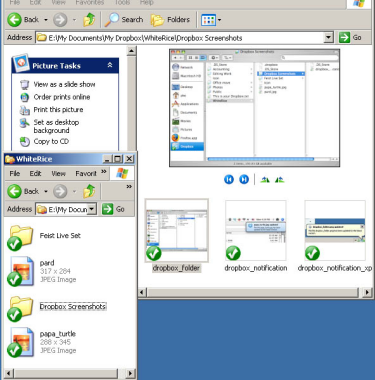
——————————————-
Mac OS X integration:
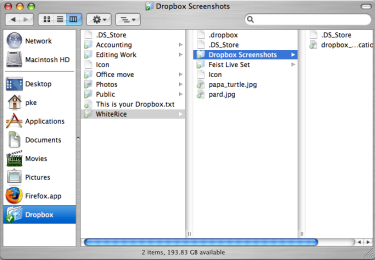
Any file that you drop into your Dropbox folder automatically uploads to the remote Dropbox servers and you can access it from your account using a web browser. You can download and install Dropbox to as many computers as you like and link it to your account. Once that’s done, any changes to the Dropbox folder are automatically reflected on all the computers on which you have Dropbox installed and linked to. Complete synchronization.
From this description, Dropbox might not sound that great, but to fully illustrate the awesomeness of Dropbox, I must describe each of the ways I use it.
Music access / sharing
With Dropbox, you simply drop a music folder into the “My Dropbox” folder and you can access your music files easily from any computer you have Dropbox installed on or through a web browser. To share your music with other Dropbox users, you can simply drop the music folder into your shared folder (more on that later). To share your music with the rest of the world, you can drop your music into the “Public” folder and send the world a link (not recommended if you want to avoid a lawsuit).
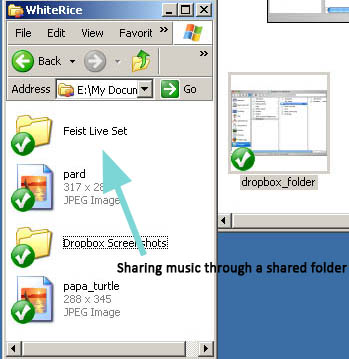
There are other music services, such as Muxtape, that allow for a more public form of music sharing. However, if your objective is to listen to your files privately among different computers or share music with a select group of friends without any uploading / listening / file format limitations, Dropbox is the clear winner.
Photo gallery
Dropbox has a slick photo gallery. There is a “Photos” folder under the main Dropbox folder. Any picture files put in the “Photos” folder are automatically available via a photo gallery. If you create sub-folders, each sub-folder is a separate photo gallery.
If you do not need to share your pictures with everybody, they can remain in your Dropbox and nobody can access them. However, in the context / right-click menu on your computer, you can get the public URL for each sub-folder’s gallery to share with everybody:
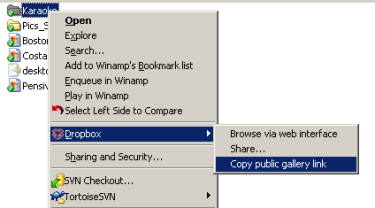
The public gallery is similar to Lightbox or Facebook galleries, with automatically-generated thumbnails:
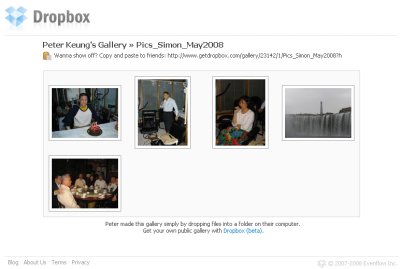
When you click a thumbnail to view the larger-size picture, you can view the previous and next photos like a slideshow:

File sharing (via a link)
There are probably thousands of file sharing websites. The usual process on one of those sites is that you use an upload form to manually put the file on the public server. Dropbox has a “Public” folder under the main Dropbox folder. There is a public URL available for any of the files placed in this folder. Simply place the file(s) you want to share in the “Public” folder, wait for the files to sync with the server, then copy the public link from the context / right menu.
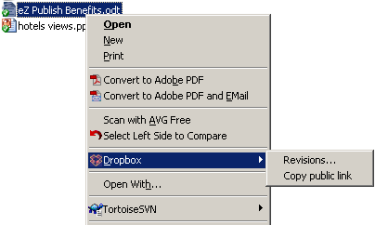
You can then share that link with your friends, family, and colleagues without having to deal with attachments or file sharing sites.
Multiple work computers
The main reason why I was drawn to Dropbox was to have an easy way to share files between my home and work computers. With the Dropbox client installed on both computers, I put all of my portable files in the Dropbox folder:
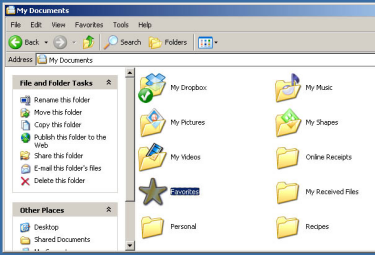
Suppose I do work in the morning on my home computer. I save my files, and head to the office for the afternoon. Once I boot up my work computer, the files that I had added or updated from my home computer are automatically updated on my work computer’s Dropbox folder. I can pick up where I left off, never having to worry about having multiple, out-of-sync repositories.
Public computers (using the web interface)
While the Dropbox client is easy to install on multiple computers, sometimes you will encounter a point where you have to use a public computer or someone else’s computer. In other words, you cannot install the client or it’s not practical to install it.
You can still access your files by logging into Dropbox’s web interface.
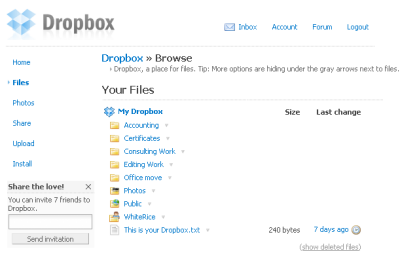
From there, download the files you need, update them, then upload them again:
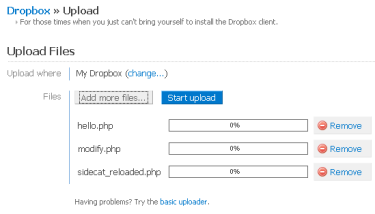
The next time you access one of your computers with the Dropbox client installed, the files will be added or updated.
Revisions and restoring deleted files
Whenever you update a file in your Dropbox, the revision is noted. You can view the history of your revisions and, if desired, restore the file back to its previous revision.
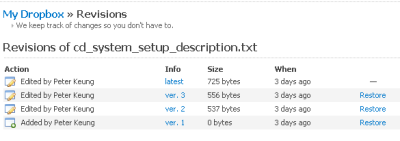
Similarly, if you delete a file and decide that you want it back, you can restore it. When browsing through your Dropbox in the web interface, you can choose to show deleted files.
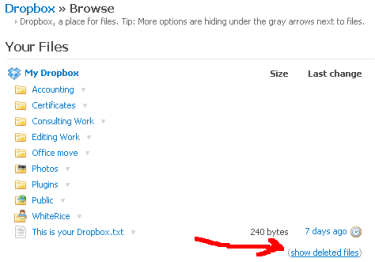
You can restore any of the deleted files (like restoring files from the “Trash” or “Recycle Bin” on your computer) or remove them completely.
File sharing using shared folders
Here’s a brief transcript of the chat that took place after Thom dropped a file into a shared folder. True story:

If you couldn’t follow the chat transcript, seconds after Thom dropped a jpg into the Shared Folder, Peter was notified of the new file, and then thanked Thom for it. Though it was a small file, the transaction speed was hella fast. On your computer, a shared folder can be identified by the 2 blank-faced dudes on the folder icon:
![]()
There are two different ways to create a new shared folder. First, you can create a new shared folder from your “My Dropbox” folder’s context / right-click menu:
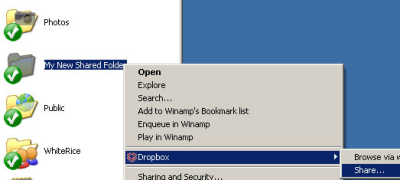
Once you click on “Share”, your browser will open the web interface for your Dropbox account. From there, you can invite other Dropbox users to partake in your shared folder fun!

The other way to create a shared folder is directly in the web interface:

While creating a new shared folder directly from the web interface is better if you’re creating a brand new folder, the first method allows you to make any existing folder into a shared one.
From the invitees’ end, they will receive a notification in their inbox about the invite, which they can choose to accept or decline. Whoever creates the shared folder has administrative control over it, and can invite or kick out users as he / she pleases. Invitees, or “collaborators” as they are called in Dropbox, are able to invite friends or leave the folder.
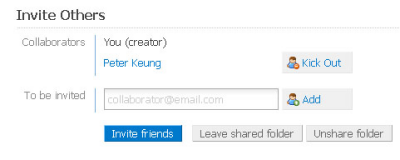
Once your shared folder is set up and the appropriate people are invited, sharing files is a joy.
Collaborative work
This article was written by two people sitting at opposite ends of the country with the help of Dropbox. In a shared folder described above, we outlined this article, drafted it (in a word processor), saved screenshots, and even sent a few messages back and forth about the article (by using text files to contain messages).
Whenever one of us uploaded or updated a file, the other party was almost instantly notified.
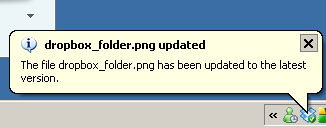
While we couldn’t work on the same file at the same time (a bit impractical unless you are working on a standard format such as in Google Docs), we had one Word file in the Shared Folder and took turns adding and editing the text in it on our own time. Dropbox took care of the automatic updating and notifications on each end, no cumbersome IM file sending required.
Communicating through Dropbox — not-so instant messaging
By no means is Dropbox intended to be a messaging solution, but there is a built-in messaging function that allows you to leave messages to your collaborators in the Shared Folder. This keeps all messages about updates, feedback, or general thoughts available within the folder that you’re collaborating on. Once you add a comment, it sends an email out to all the collaborators informing them a comment was added.
You can also employ a makeshift messaging system by creating a text file in a shared folder. The text file is ideal as opposed to another file format because it is quick and simple, and can be viewed directly in a web browser if needed.
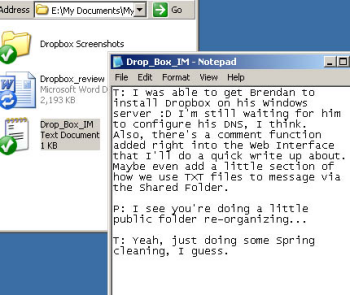
After adding a new message in the text file and saving it, your collaborators will get a notification that the file has been updated, which essentially means that there is a new message.

There are obviously more efficient ways to sending instant messages, but the methods described above allow for messages to be sent when you cannot reach a collaborator through an IM program, such as MSN, or if you want the messages saved in some form of repository. It’s also faster than sending an email or replying to one.
Future uses
As a Linux client is upcoming, it would be handy to install the client on a server in order to sync and work on website files, eliminating the need to use FTP, SSH, or SVN clients. This can also be done on a Mac OS X or Windows server (I’ve successfully tested this) by using one of the sub-folders under your Dropbox folder as the “pub_html”, “httpdocs”, “www” or similar folder.
Storage space and conclusion
Currently, new Dropbox beta users receive two gigabytes of storage space to hold all files, revisions, and deleted files. This is plenty of space for your document, music, and picture needs. It is not enough if you are sharing large videos, but to make good use of Dropbox’s speed and efficiency, use something else for such needs.
Even though you run the risk of a remote server crapping out and losing your hosted files, there’s little worry since everything is always backed up on your local machine, or machines (assuming, in a worst-case scenario, that you can disconnect your computer before it syncs with an empty dropbox account by deleting every file). And if you have shared folders, there will back-ups of the files on each of your collaborators’ machines. However, if you wanted to access files through the web interface if the servers go down, you’re SOL. But that’s a risk I’m more than willing to take.
Dropbox is currently free for everybody, but it will probably also offer premium, paid accounts with more storage and features when it is officially open to the public. I have been so impressed by it so far that I think an account is worth a few dollars per month even for its current offering.
Microsoft Cloud OS
In addition to making available its existing services, such as mail and instant messaging, Microsoft also will create core infrastructure services, such as storage and alerts, that developers can build on top of. It's a set of capabilities that have been referred to as a "Cloud OS," though it's not a term Microsoft likes to use publicly.
"Cloud-centric is probably a better way to say it because Cloud OS makes it sound like it is only running on the cloud," said Brian Hall, general manager of Windows Live. "A lot of the data, a lot of the apps, a lot of the interesting things are on the edge. They are on the PCs. They are on the Xboxes. They are on the phones."
But, quibbles over nomenclature aside, Microsoft made clear this week that it aims to play the same role on the Internet that it plays today on the desktop--that of providing its own applications as well as the underlying plumbing and tools that developers use to build their products.
In a speech to partners at its Worldwide Partner Conference here, Microsoft Chief Executive Steve Ballmer promised that the company would be talking to developers later this year about the first version of its developer platform, some pieces of which are currently available in beta form. Hall echoed the message that Microsoft plans to open up much of the technology that powers Windows Live as well as the underlying infrastructure.
"What's ours is yours," Hall told the crowd.
The ambitious promise comes more than a year and a half after Bill Gates first announced the company's plans for Windows Live at a November 2005 event in San Francisco. Since then Chief Software Architect Ray Ozzie and a team have been working on turning Microsoft's Internet business from a series of separate services offered directly by Microsoft into a set of more unified services that can be offered either by Microsoft directly or through partners.
At this year's Mix '07 show, Ozzie, who has been crafting the Live strategy, did talk about allowing programmers access to some of its higher-level services, such as Windows Live Spaces. But he was largely silent on the topic of the underlying developer platform.
"I've nothing to announce in that realm at this time," Ozzie told CNET News.com in an interview then. "Yet, it's pretty clear that we're working on some stuff."
Late last month, Microsoft introduced two new Windows Live Services, one for sharing photos and the other for all types of files. While those services are being offered directly by Microsoft today, they represent the kinds of things that Microsoft is now promising will be also made available to developers.
Among the other application and infrastructure components, Microsoft plans to open are its systems for alerts, contact management, communications (mail and messenger) and authentication.
"Windows Live is here as a platform for our partners," Hall said. That's not exactly the case--yet. Microsoft has made a couple of pieces, such as its Virtual Earth service, available commercially. Other components are available either for broad or limited testing, while still others have yet to be offered to developers. Instant messaging, for example, will be made broadly available to developers in test form in October.
'A real computer science challenge'
One of the key challenges Microsoft faces is trying to write tools that allow developers to code in such a way that it doesn't necessarily matter if it is a phone or a PC that is accessing the service, or whether a file is stored locally or in the cloud.
"There's a real computer science challenge for abstracting all of that well, abstracting how do you find and manage devices, how do you access devices and do it in a way that is transparent to the developer," Hall said.
Hall likens it to Windows in its early days.
"A lot of what Windows was doing early on was memory management, storage, all of the things today we take for granted," Hall said. "The vast majority of developers (today), they are not thinking, 'how am I going to store this particular piece of data in memory?' It just happens. The same thing is going to happen in the mesh model."
Microsoft is also trying to make sure that its business terms are attractive enough to woo the next MySpace or YouTube to bet on its technology. It has spent months talking to existing partners, but also to venture capital firms and start-ups.
For now, Microsoft is offering up many of its services free for up to 1 million users, while saying it wants to strike some kind of deal if a service exceeds that threshold.
"If this becomes a big, big commercial success we want to have a value exchange, but we'll give you plenty of ramp room," Hall said.
As it works to build out the underlying core services, Microsoft is also offering up applications to partners, such as Windows Live Hotmail, Windows Live Messenger and the Spaces blogging tool.
Until now, most of the deals have been one-off deals that the company has had to individually negotiate. Among Microsoft's early deals are a few colleges and universities, such as the University of Pennsylvania, as well as some telecommunications firms. On Wednesday, Microsoft announced a deal with Qwest, which will offer its Internet subscribers the option of using a Qwest-branded version of Microsoft's Windows Live services.
"It was a much more custom engagement model," Hall said. "Now we are moving to a scalable come one, come all approach."


